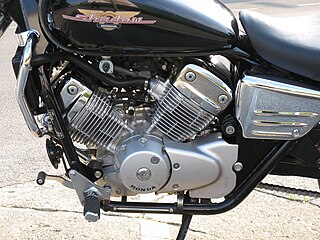
A V-twin engine, also called a V2 engine, is a two-cylinder piston engine where the cylinders are arranged in a V configuration and share a common crankshaft.

The RD350 is a two-stroke motorcycle produced by Yamaha from 1973 to 1975. It evolved directly from the piston port, front drum-braked, five-speed Yamaha 350 cc "R5".

The Honda CX series motorcycles, including the GL500 and GL650 Silver Wing variants, were developed and released by Honda in the late 1970s, with production ending in most markets by the mid 1980s. The design included innovative features and technologies that were uncommon or unused at the time such as liquid cooling, electric-only starting, low-maintenance shaft drive, modular wheels, and dual CV-type carburetors that were tuned for reduced emissions. The electronic ignition system was separate from the rest of the electrical system, but the motorcycle could only be started via the start button.
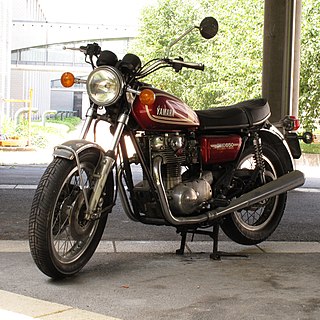
The Yamaha XS650 is a mid-size motorcycle made by Yamaha Motor Company. The standard model was introduced in October 1969,and produced through 1979. The "Special" cruiser model was introduced in 1978 and produced through 1985. The XS650 began with the 1955 Hosk SOHC 500 twin. After about 10 years of producing 500 twin, Hosk engineers designed a 650 cc twin. Later the Hosk company was acquired by Showa Corporation, and in 1960 Yamaha had bought Showa with Hosk's early design of 650 cc twin.

The Audi S6 is the performance variant of the Audi A6, an executive car produced by German automaker Audi. It went on sale in 1994, shortly after the "A6" designation was introduced, replacing the "100" nameplate.
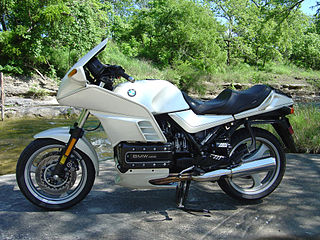
The BMW K100 is a family of four-cylinder 987 cc motorcycles that were manufactured by BMW from 1983 to 1992.
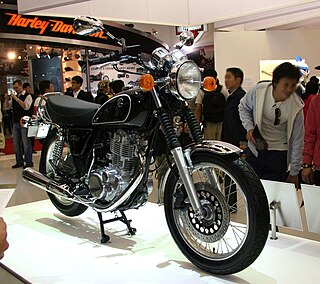
The Yamaha SR400 (1978–2021) and SR500 (1978–1999) are single-cylinder, air-cooled, two-passenger motorcycles manufactured in Japan by Yamaha Motor Company as a street version of the Yamaha XT500, with a standard riding posture and styling resembling the Universal Japanese Motorcycles of the 1970s. The two models differ by their engines: the SR400 engine has a lower displacement, achieved with a different crankshaft and shorter piston stroke and both models feature only kickstarting, i.e., no electric starter.
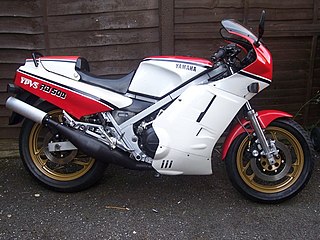
The Yamaha RD500LC is a high-performance, two-stroke sports motorcycle, also known as the RZ500 in Canada and Australia. A lightened but detuned version known as the RZV500R was developed for the Japanese home market. Strict United States Environmental Protection Agency regulations meant that the RZ500 was not available for sale in that country. Produced for a short period between 1984 and 1986 it has become a sought after collector's machine.

The Yamaha RX 100 was a two-stroke motorcycle made by Yamaha from 1985 to 1996 with technical collaboration and distributed in India by the Escorts Group. At the initial stage, Yamaha Japan was exporting all bikes from Japan to India. After 1990, Escorts started production in India, with some parts being imported from Japan.

The Yamaha FZ750 is a sports motorcycle produced by Yamaha Motor Corporation between 1985 and 1991. The FZ750 is notable for several reasons, perhaps the most radical being the 5-valve cylinder head with a radial arrangement. This became something of a Yamaha trademark. The FZ750 would be the first bike in the Genesis design concept.
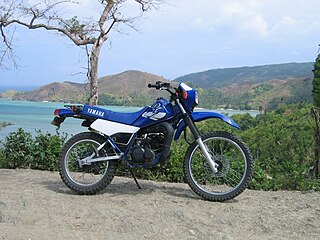
The Yamaha DT125 is a motorcycle produced by Yamaha Motor Company that was first launched in 1974 as the DT125A and is still sold in some markets to this day. The model designation DT indicates that it is a two-stroke, off-road-styled motorcycle, it has a raised exhaust, handlebars with cross members, universal tires, and adequate ground clearance for an off-road enduro motorcycle or trail motorcycle. The USA received the last DT125H in 1981.
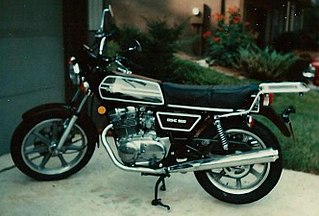
The Yamaha TX500 is a two-cylinder standard motorcycle built by Yamaha and sold in 1973 and 1974. Early models closely resembled the Triumph Bonneville in style. In 1975 the bike was renamed XS500 and then continued to be updated until 1978 when sales ended in the USA. In Europe, the model was available through 1980.
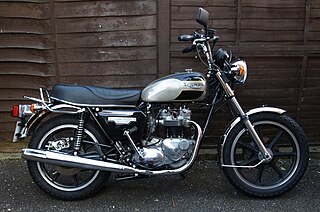
The Triumph Bonneville T140 is a standard motorcycle with a 750 cc (46 cu in) capacity engine that was designed and built by Triumph Engineering at Meriden near Coventry.
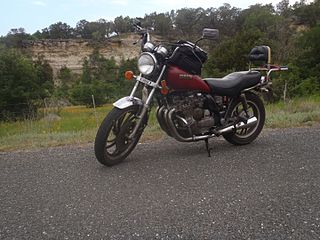
The Yamaha XJ650 Maxim is a mid-size motorcycle by the Yamaha Motor Company introduced in 1980 as the Maxim I and produced through 1983. Yamaha designed the high-performance XJ650 as a brand-new four-cylinder with shaft drive, and built it specifically as a special cruiser. The XJ Maxim was the successor of the XS Special introduced in 1978.

The Honda CBX550F is a four-stroke, in line four cylinder, sport tourer motorcycle produced from 1982 to 1986 by the Honda Motor Company. The CBX550F II is identical apart from the addition of a half-fairing.

The G450X is an Enduro-class motorcycle that was produced by BMW Motorrad between 2008 and 2011.
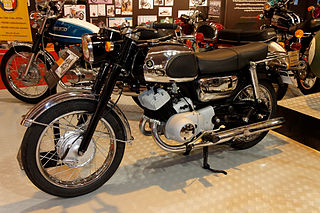
The Suzuki T10 is a 246 cc (15.0 cu in), two-stroke, twin-cylinder motorcycle produced by the Japanese Suzuki company between 1962 and 1967. The model was based on the earlier Colleda TT and had an improved frame. It was marketed as the El Camino in the US and was Suzuki's first twin the be sold in America.

The Suzuki GT250, also known as the Suzuki Hustler in the US is a 247 cc (15.1 cu in), two-stroke, twin-cylinder motorcycle produced by the Japanese Suzuki company between 1971 and 1981. The model was developed from the earlier T250, and was one of the best selling motorcycles in its class. For 1978 the bike was redesign and marketed as the GT250 X7. The X7 was capable of reaching 100 mph (160 km/h) in favourable conditions. The model range was discontinued in 1981 in favour of Suzuki's four stroke models, and the X7 was developed into the RG250 Gamma.

The Ducati Forza is a 340 cc (21 cu in) single cylinder bevel drive SOHC motorcycle produced by the Spanish manufacturer MotoTrans, who were licensed by Ducati to produce motorcycles under the Ducati brand name and was produced from 1976 to 1983. The model is based on the 350 'wide case' Ducati singles which the Italian Ducati factory had stopped manufacturing in 1974, but which MotoTrans continued to develop and produce.

The Laverda 1000 is a series of 981 cc (59.9 cu in) air cooled DOHC triple motorcycles produced by the Italian manufacturer Laverda between 1973 and 1988. The high-performance variant, the Jota, was the fastest production motorcycle from 1976 to 1981. Approximately 7,100 triples of the various models were produced.























